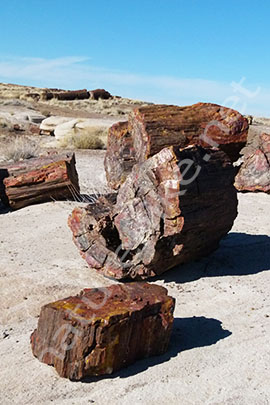 | |
The Park is located in NAVAJO and APACHE counties
in northeastern Arizona, about 25 miles east of HOLBROOK, AZ. (About 50 miles from the State of New Mexico border on I-40 Hwy)
There is no public transportation to or within the park.
Petrified Forest National Park stretches north and south between I-40 and Highway #180.
Driving from PHOENIX:
You have several choices, depending on your location in the greater PHOENIX area:
From the north and west side of greater Phoenix; travel I-17 north to FLAGSTAFF (about 144 mi/2 hrs 15 mins driving) and continuing on I-40
east (about 110 mi/1 hour 40 mins driving),
From eastern side of greater Phoenix; travel Highways #87 north to PAYSON, on #260 east to HEBER, on #377 north to HOLBROOK,
and on #180 South to the park (a total of 215 miles).
Driving from ALBUQUERQUE,NM;
Travel on #204 west on I-40 to Exit 311.
For more information call to VISITOR CENTER at 928-524 6228 (or Fax 928-524 3567) for both areas. National Park is open All Year 8:00am - 5:00pm MST, except 25th
of December. (Summer hours may change, so please call Visitor Center before your arrival). Please note that Arizona does not observe daylight savings time. No
Reservations are needed to enter either Park.
| 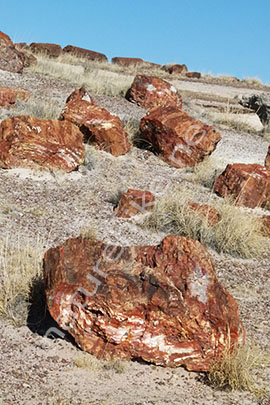
|
There are two entrances into the park.
Your direction of travel dictates which entrance is best for you: 
Westbound I-40 travelers should take Exit 311, drive the 28 miles through the park and connect with Highway #180 at the south end.
Travel 19 miles on highway #180 north to return to I-40 via HOLBROOK.
Eastbound Interstate 40 travelers should take Exit 285 into HOLBROOK then travel 19 miles on highway #180 south to the park's south entrance. Drive the
28 miles north through the park to return to I-40.
Petrified Forest National Park offers to visitors a 27 mile paved loop road which cover all this area including
section of the scenic Painted Desert.
Travel time through the park is at least 45 minutes, though an average visit is 2-3 hours with stops at viewpoints
or trails along the park road.
So, the visitors freely can drive on this loop and can make stops and/or park their vehicles at several designated paved areas for
site seeing and photography. Petrified logs are extremely beautiful with most unexpectedly bright colors.
|

|
The PETRIFIED FOREST
is adjacent to the Painted Desert, so it is a great opportunity to visit both historical sites in a single trip.
I have visited this "Nature Wonders" 3
times and always enjoyed.
|

Petrified Forest National Park is a
surprising land of scenic wonders and fascinating science, covers about 146 square miles (380 km2), encompassing semi-desert shrub steppe as well as highly eroded
and colorful badlands. About half of the park is designated wilderness.
Scientific studies are on-going at the park. Paleontologists find new fossils, including new
species of plants and animals, each year.
Biologists study living plants and animals, including vegetation surveys and reptile, amphibian, and mammal projects.
The park's earliest human inhabitants arrived at least 8,000 years ago. By about 2,000 years ago, they were growing corn in the area and shortly thereafter
building pit houses in what would become the park. Later inhabitants built above-ground dwellings called pueblos. Although a changing climate caused the last of the
park's pueblos to be abandoned by about 1400 CE, more than 600 archeological sites, including petroglyphs, have been discovered in the park. In the 16th century, Spanish
explorers visited the area, and by the mid-19th century a U.S. team had surveyed an east-west route through the area where the park is now located and noted the
petrified wood. Later roads and a railway followed similar routes and gave rise to tourism and, before the park was protected, to large-scale removal of fossils.
|
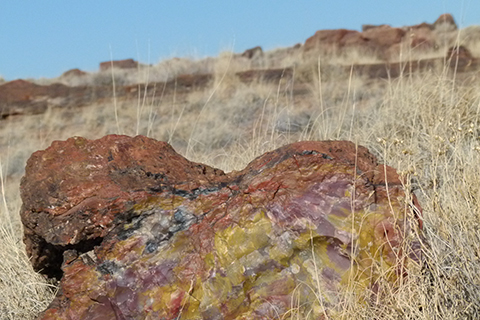 |
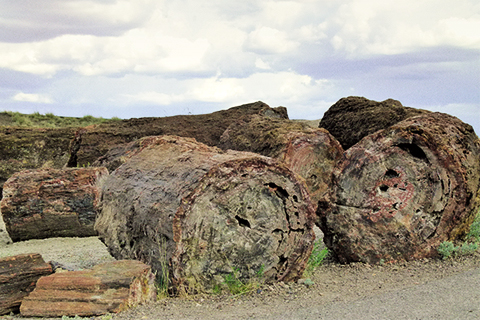
|
Averaging about 5,400 feet (1,600 m) in elevation,
the park has a dry windy climate with temperatures that vary from summer highs of about 100 F (38 C) to winter lows well below freezing. There is occasional snow in the
winter. High winds can happen any time of year. For actual weather condition click
here
to see 'The Weather Channel' website.
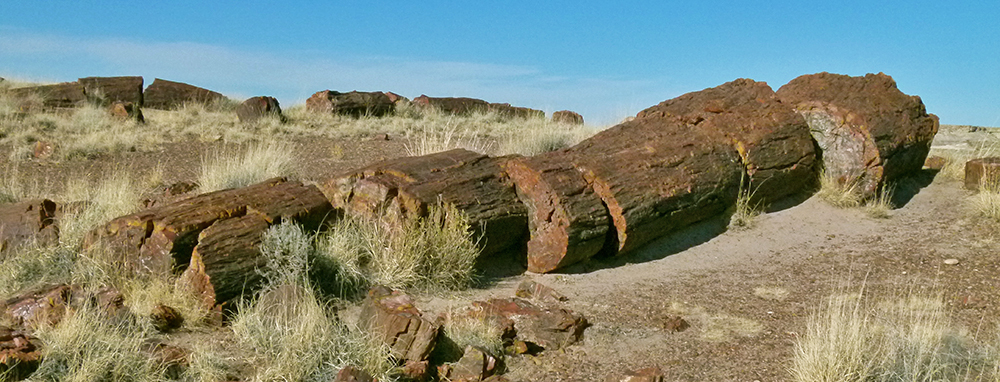
After seeing picture above, you might race this obvious question:
Why do the petrified logs look like someone cut them with a saw?
OK, here is the answer what I learned with that:
Petrified wood is mostly silica-quartz. The logs are very hard , but brittle. During stress after petrification, but while the logs were still encased in matrix rock,
the logs cracked. As the logs eroded out, from gravity and ice wedging, the cracks widened and segments separated. Silica naturally breaks on a clean angle".
More than 400 species of plants, dominated by grasses such as bunchgrass, blue grama, and sacaton, are found in the park. Fauna include larger animals such as
pronghorns, coyotes, and bobcats; many smaller animals, such as deer mice; snakes; lizards; seven kinds of amphibians, and more than 200 species of birds, some of which
are permanent residents and many of which are migratory.
|
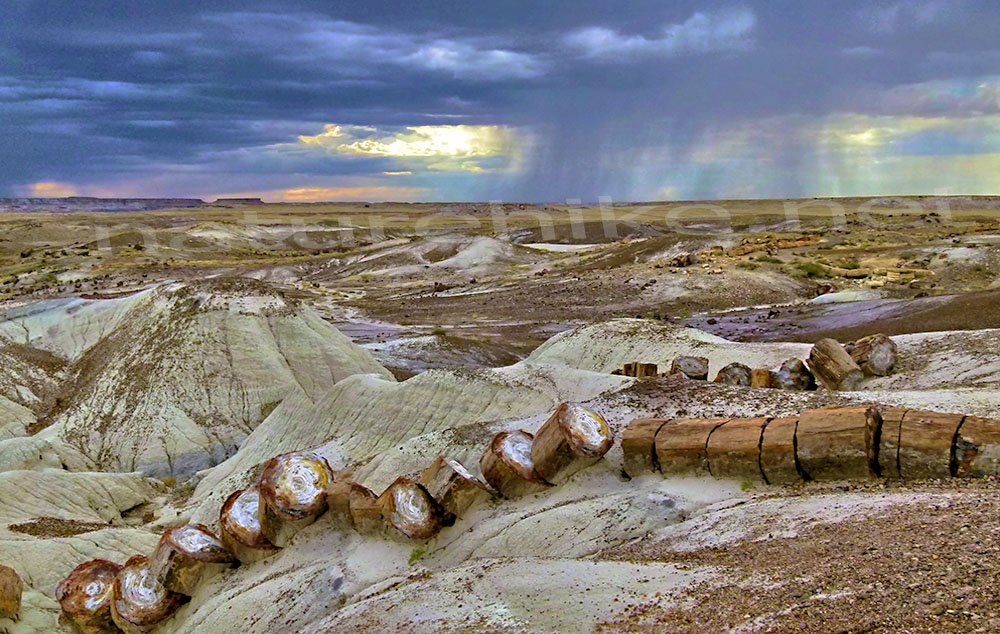
|
As my picture above shows the PETRIFIED FOREST
is a forest made out of fossil or petrified wood. In other words, it is a forest made out of stone trees. I was lucky to capture this pic in one of my trip there during
a stormy day. Petrification is a natural process that occurs when all organic material in a tree dies and is replaced by a combination of quartz, copper, iron, and other
minerals. Once the process has been finalized, petrified wood is no longer considered wood, and it becomes classified as a stone.
You already noticed that so many logs concentrated in same area because this was a large river system with galleries of trees (mostly were kind of
coniferous trees, tree ferns, and some gingkoes) along the waterways. As the trees died naturally over many years, some floated downstream to form log jams.
The various "forests" in the park are those log jams.
Your other question in your mind can be as it was in mine:
Is this the largest concentration of petrified wood?
"PETRIFIED FOREST is considered one of the largest concentrations in the world, with other large ones found in North Dakota/USA, Argentina,
and Egypt.
|
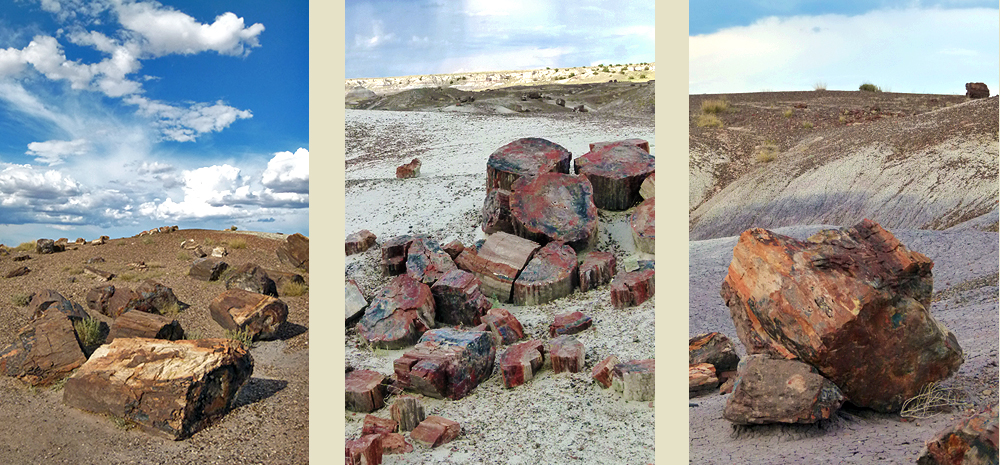
PETRIFIED FOREST present different colors, depending on the type of material once absorbed by the living trees. Cobalt and
copper cause a greenish blue tint, while manganese turns the wood pink, and carbon produces gray. Some trees have more than one color, while others are basically composed
of crystal quartz, which are transparent and allow for a view of the grain wood. Minerals and impurities deposited while the wood was petrifying add interesting
patterns. White color that you see on the ground is not a trace of snow, it is volcanic ash.

 Collection of plants, fossils, petrified wood, archeological material or other objects is
strictly prohibited! Collection of plants, fossils, petrified wood, archeological material or other objects is
strictly prohibited!
|
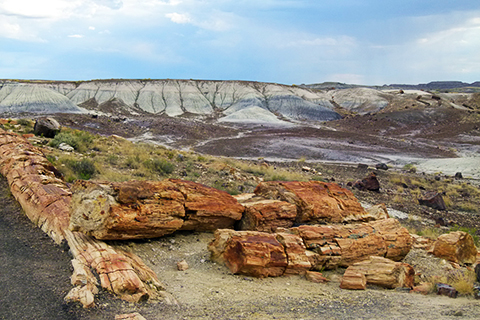 |
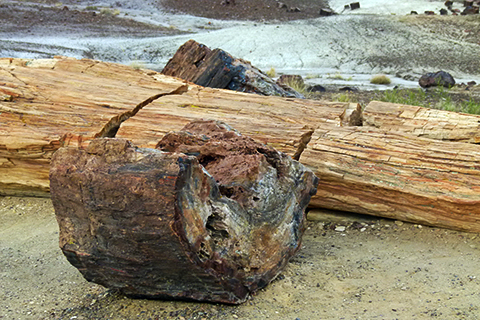
|
 There is no lodging or campgrounds in
Petrified Forest National Park and does not allow car camping. For regular daily visit,
yes, road and parking areas are suitable for larger RVs, even those with towed vehicles. Off road vehicle travel is not allowed within the park, including
mountain bikes. Options for RV/tent camping exist outside the park. Backpacking in the Petrified Forest National Wilderness Area is allowed for the more
adventurous.
There is no lodging or campgrounds in
Petrified Forest National Park and does not allow car camping. For regular daily visit,
yes, road and parking areas are suitable for larger RVs, even those with towed vehicles. Off road vehicle travel is not allowed within the park, including
mountain bikes. Options for RV/tent camping exist outside the park. Backpacking in the Petrified Forest National Wilderness Area is allowed for the more
adventurous.
Day hiking is permitted in the park, but overnight camping is permitted only within the designated wilderness unit. All day hikers must be back in their vehicles
driving towards one of the park exists by the posted park closing time. Permit for this stop being issued one hour before the park closes. Groups using the wilderness
areas overnight are restricted to 15 persons.
At the outside entrance of the north end of the park there is a Cafe and a gas station that features a travel store. Call (928) 524-3756 for further information.
Information on entrance fees to the Park with 7 days permit is follows:
$10 for private non-commercial vehicle, $5 for individual entry (bike or foot),
$20 for 'Annual Pass' for private non-commercial vehicle.
Petrified Forest & Painted Desert Parks honors the 'Gold Access', 'Golden Age' and 'Golden Eagle'
Passports.
|

There is PAINTED DESERT INN building, which is a National Historic Landmark within PETRIFIED FOREST (at Kachina Point,
1,8 Miles North of North Entrance Station) offer stunning views of the Painted Desert INN open 10 am-4 pm daily. The Painted Desert Rim Trail (0.5 mi/0.8
km one way) begins here. The building functions only as a museum and bookstore today, without overnight accommodation and food service. There is public restroom
by entrance of the back side of the building. For more information call INN at 928-524 6228.
Finally you may rise this question:
Where does the petrified wood sold in the rock shops outside the park come from?
The answer what I got is: Petrified Forest National Park protects less than 20% of the
petrified wood in northeastern Arizona. Petrified wood is also found on state land, Bureau of Land Management land, the Navajo Nation, and privately owned property.
The wood being sold in regional gift shops comes from the private property, from which it can be collected by the owner, or those with
permission from the owner, and sold.
|
|
Did you know these?
Petrified Forest National Park is the only national park unit to protect a section of Historic Route 66!
The ecosystem at Petrified Forest National Park is not desert. It's one of the largest areas of intact
grassland in the Southwest.
|
|
|
| 
|
 The WAVE, Arizona/USA
The WAVE, Arizona/USA
 ANTELOPE CANYON, Arizona/USA
ANTELOPE CANYON, Arizona/USA
 American Native's HOOP DANCE
American Native's HOOP DANCE
 MONUMENT VALLEY (Arizona & Utah/USA)
MONUMENT VALLEY (Arizona & Utah/USA)
 THE CANADIAN ROCKIES (B.C./CANADA)
THE CANADIAN ROCKIES (B.C./CANADA)
 TENT ROCKS (New Mexico, USA)
TENT ROCKS (New Mexico, USA)
 YELLOWSTONE NATIONAL PARK (WYOMING, Montana, and Idaho/USA)
YELLOWSTONE NATIONAL PARK (WYOMING, Montana, and Idaho/USA)
 BISTI / DE-NA-ZIN Wilderness (New Mexico/USA)
BISTI / DE-NA-ZIN Wilderness (New Mexico/USA)
 BEARIZONA WILDLIFE PARK (Arizona/USA)
BEARIZONA WILDLIFE PARK (Arizona/USA)
 COKE OVENS OF AZ (Arizona/USA)
COKE OVENS OF AZ (Arizona/USA)
 HOUSES IN BARRIO DISTRIC (Tucson, Arizona/USA)
HOUSES IN BARRIO DISTRIC (Tucson, Arizona/USA)
 WILD HORSES at White Mtn area (Arizona/USA)
WILD HORSES at White Mtn area (Arizona/USA)
 Back to HOME PAGE
Back to HOME PAGE
|
|
|
All Rights Reserved. ©
2008-2025 NATUREHIKE.NET. This site was created by Tanju Bayramoglu and launched in 2008 and updated on March 2025. Powered from Phoenix,USA. The majority of the text
used in this presentation has been taken from various sources on the Internet. All images appearing in this site are the exclusive property of
www.NATUREHIKE.net and in any form may not be reproduced, copied, stored, or manipulated without the written permission of
Tanju Bayramoglu.
|
|
| |













